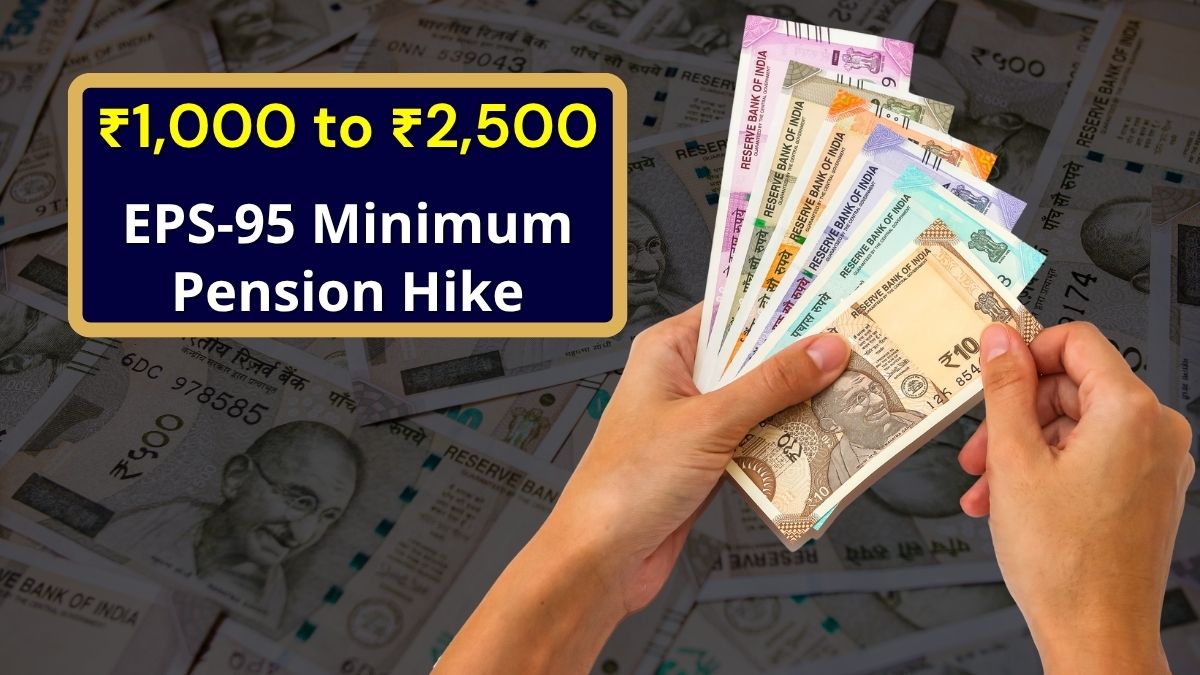Have you ever thought about how far ₹1,000 can stretch in today’s world? Probably not very far — maybe a few groceries or a utility bill. Now imagine trying to live an entire month on that. That’s what many pensioners under the Employees’ Pension Scheme (EPS-95) have been doing for years.
But that may soon change. The Employees’ Provident Fund Organisation (EPFO) is finally considering a long-awaited reform — raising the minimum monthly pension from ₹1,000 to ₹2,500. For more than 11 years, this amount has remained unchanged. And for millions of retired employees, this news could mean more dignity and stability in their golden years.
What’s Happening?
According to reports, the proposal to increase the minimum pension will be taken up during the Central Board of Trustees (CBT) meeting on October 10–11, 2025, in Bengaluru.
The current ₹1,000 pension was introduced back in 2014 — when inflation was lower and living costs were manageable. Since then, everything from food to medicines to rent has become significantly more expensive. Many pensioners have been demanding an increase for years, with some unions even pushing for ₹7,500 per month.
The proposed ₹2,500 pension, while still below that demand, is being viewed as a realistic middle ground — one that balances pensioner welfare with government affordability.
Why This Matters: Inflation Has Eaten Away Real Value
Let’s look at the numbers. Based on data from the Reserve Bank of India, the average inflation rate from 2014 to 2024 was around 5.5% per year. In simple terms, ₹1,000 in 2014 would now be worth about ₹1,700–₹1,800.
So, even though ₹2,500 might not sound huge, it restores the purchasing power pensioners had a decade ago — and adds a small cushion against future inflation.
Think about it this way: a retired worker who’s been struggling to manage monthly medical bills or groceries could now have an extra ₹1,500 each month. That’s the difference between cutting corners and living comfortably.
Budget Challenges Ahead
Of course, there’s no free lunch — even in government finances. The central government currently contributes 1.16% of wages (up to ₹15,000/month) toward EPS-95.
If this hike is approved, it will likely add ₹3,000–₹4,500 crore in extra budgetary spending every year. That’s a big commitment, especially at a time when the government is balancing social welfare with fiscal discipline.
Still, the Ministry of Labour and Employment is expected to work closely with the Finance Ministry to make this happen, considering the strong public sentiment behind the move.
Comparing EPS-95 with Other Pension Schemes
When you look at other social pension programs, the gap becomes obvious.
For instance, under the Indira Gandhi National Old Age Pension Scheme (IGNOAPS), beneficiaries receive between ₹200 and ₹500 monthly from the Centre, and some states top it up to reach ₹2,000–₹3,000.
So, the proposed ₹2,500 minimum under EPS-95 would finally bring it closer to parity with other pension schemes and create a fairer system across states and sectors.
Boost to Local Economies
Here’s another interesting angle — this isn’t just a welfare move; it’s an economic stimulus too.
An extra ₹1,500 a month for around 15 lakh pensioners translates to roughly ₹270 crore in additional monthly spending across India. Most of this money will flow into Tier 2 and Tier 3 towns, boosting local markets.
Small shops, healthcare services, and FMCG brands could all see a noticeable bump. And with Diwali season approaching, the timing couldn’t be better for a short-term consumption boost.
Is the EPFO Ready?
Behind the scenes, the EPFO is modernising its systems under “EPFO 3.0”, aiming for smoother digital operations.
This includes real-time pension tracking, UPI-linked withdrawals, and automatic adjustments to pension accounts. If the hike is approved, EPFO will need to recalibrate its systems and ensure a seamless rollout.
The upcoming CBT meeting is expected to finalise vendor partnerships and implementation timelines to make sure retirees start seeing the benefits without bureaucratic delays.
What This Means for Investors
Interestingly, this move might even impact the stock market.
Higher disposable income among pensioners means stronger spending on consumer goods, healthcare, and retail products — all good news for FMCG and pharma companies.
However, the added government spending of ₹3,000–₹4,500 crore could make bond investors slightly cautious. Still, most experts see this reform as consumption-friendly, supporting growth from the ground up rather than relying on big corporate subsidies.
The Bottom Line
After 11 years of waiting, India’s pensioners might finally get the long-overdue respect and relief they deserve.
The proposed hike under EPS-95 isn’t just about numbers — it’s about restoring dignity, ensuring financial comfort, and recognising decades of hard work by millions of employees who built the foundation of India’s economy.
If approved, it could mark a turning point in how we treat our retirees — not as dependents, but as valued citizens who deserve security and peace in their later years.
Frequently Asked Questions
1. What is EPS-95?
EPS-95 (Employees’ Pension Scheme 1995) is part of the EPF system, providing a monthly pension to employees with at least 10 years of service.
2. When will the ₹2,500 minimum pension be implemented?
The proposal will be discussed in the October 2025 CBT meeting. Implementation dates will depend on approval and system readiness.
3. How many pensioners will benefit from this change?
Around 15 lakh pensioners are expected to benefit from the proposed ₹2,500 minimum pension hike under EPS-95.
✅ Suggested SEO Title:
EPFO ₹2,500 Minimum Pension Hike: What It Means for EPS-95 Pensioners

ప్లాన్, ఎక్సపెక్ట్ ఇవ్వన్ని వద్దు 2500/7500 ఊహించి చివరికి తుస్స్ మనిపిస్తున్నారు. దయచేసి పక్కాగా డిక్లేర్ చేసిన తర్వాత మెసేజ్ పెట్టండి కలలు కల్లలు అవుతున్నాయి
Plan, expectation 2500/7500 all these stories waste.Nothing is hapening so far So please put message after final announcement with proof.